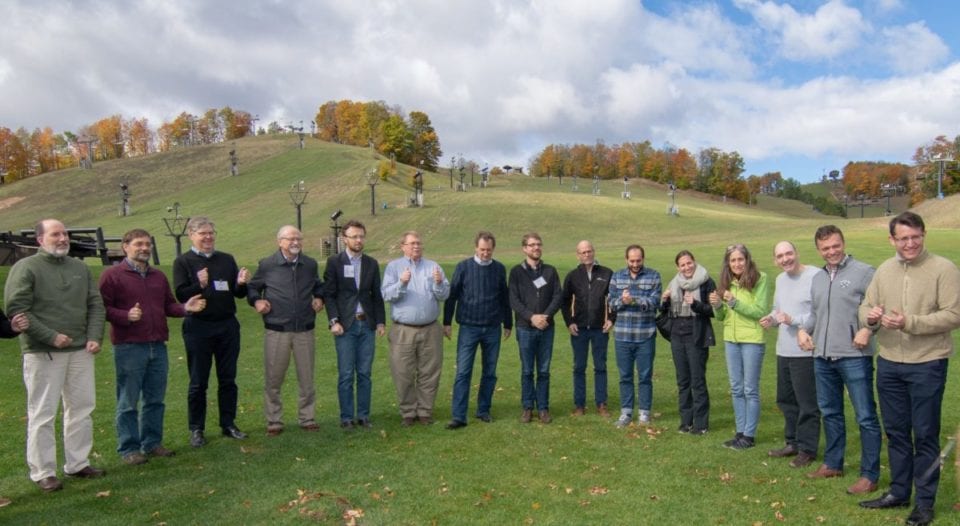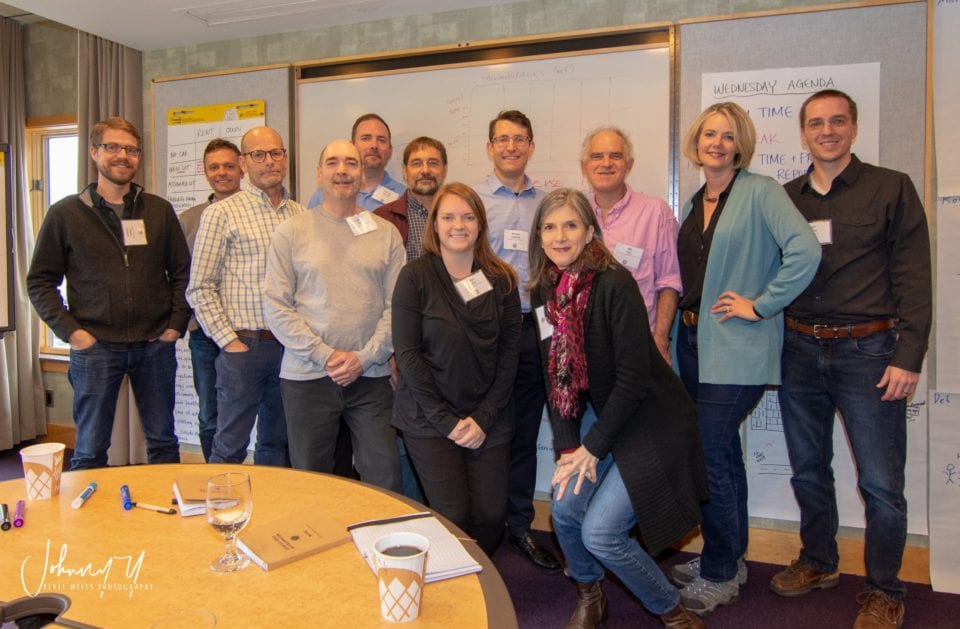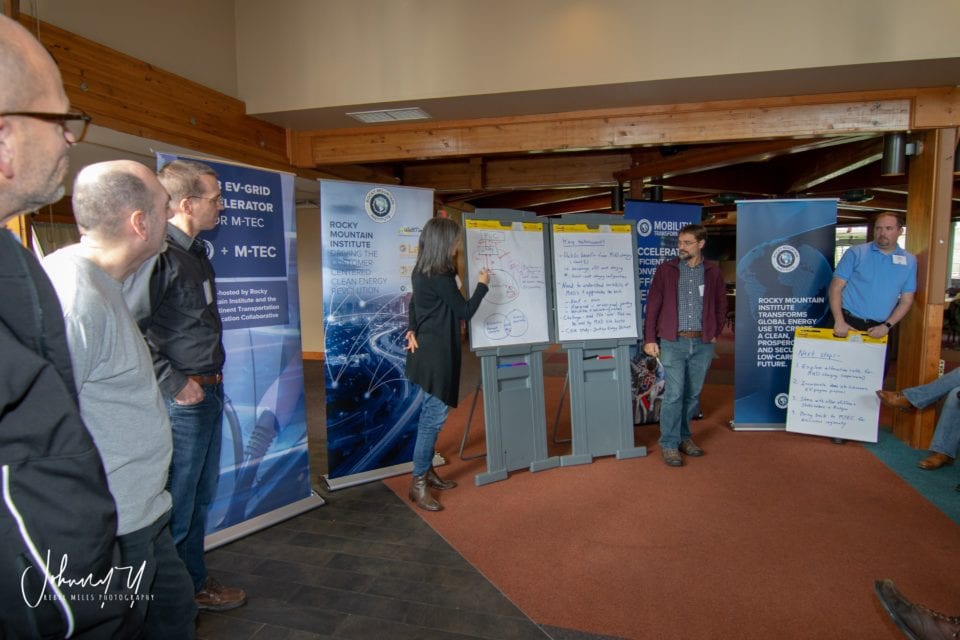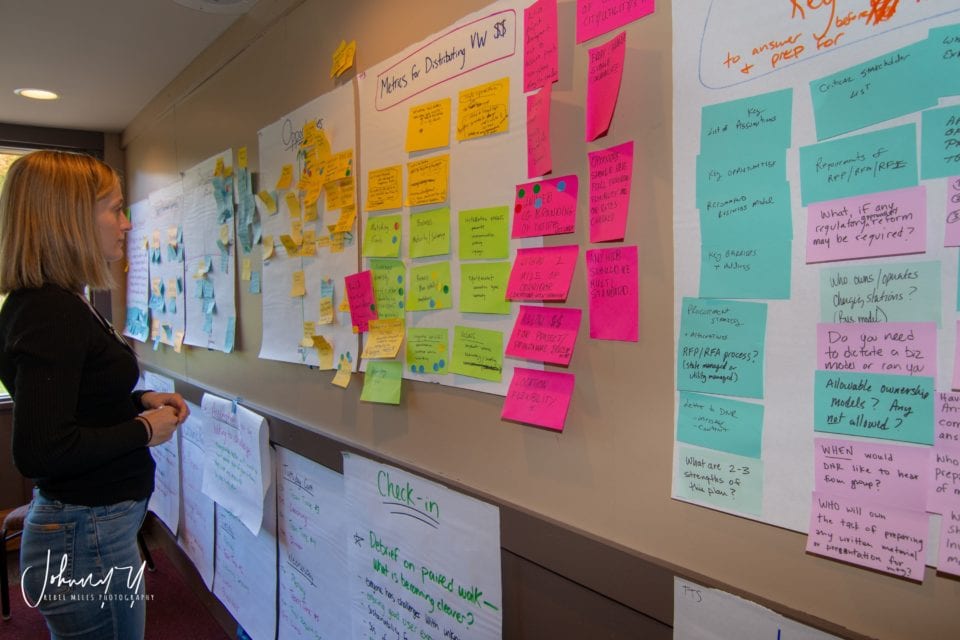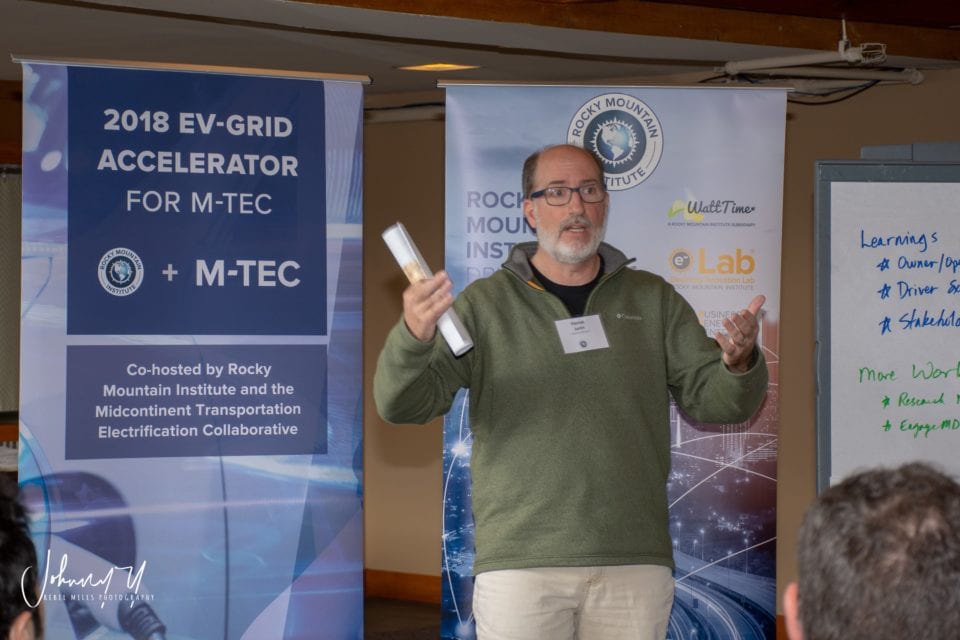electrical care charging in an autumn cityscape
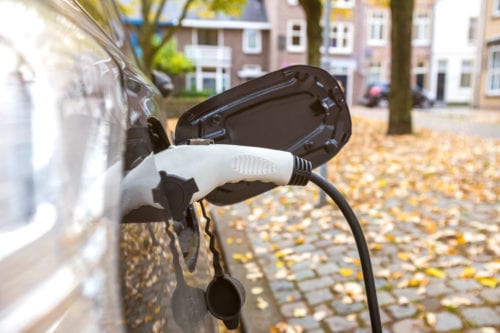
Under the Hood of the Leading Transportation Projects in the Midwest: A Snapshot of RMI and M-TEC’s First Mobility Accelerator
The wheels of electric transportation in the United States are spinning at a rapid clip. Battery electric and hybrid electric vehicle (EV) sales jumped 28 percent from 2017 to 2018. Model availability and range are increasing, enabling more Americans to make the switch to electric. This momentum is not limited to light duty vehicles—from Sebastopol, California, to Broward County, Florida, transit agencies around the country are starting to shift to electric buses while leading American companies are beginning to incorporate electric delivery vehicles into their fleets at scale. Nationwide, availability of EV charging is poised to grow as states are starting to distribute $2 billion of the Volkswagen settlement earmarked for charging infrastructure.
Despite this momentum, many on-the-ground challenges remain before electric-powered rubber hits the road at scale. In order to find solutions to these challenges, Rocky Mountain Institute hosted an Accelerator workshop, a multiday working meeting to accelerate high-impact, innovative projects, and partnered with the Midcontinent Transportation Electrification Collaborative (M-TEC) to leverage its regional network and knowledge. We called the event the RMI/M-TEC EV-Grid Project Accelerator, and are thrilled that this event launched RMI’s new mobility-focused Accelerators. Modeled after RMI’s e–Lab Accelerator, the event brought together multi-stakeholder project teams, industry experts, and trained facilitators to focus on solving complex mobility problems.
In a previous blog, we described the important role of RMI’s Accelerators in our overall mobility strategy. In this piece, we want to provide a snapshot of the projects at the workshop, the important challenges identified, and the teams’ progress during the event.
Accelerating Electric School Buses
Coming into the Accelerator, our view of this project was narrow: limited to procuring and deploying electric school buses. Now, we have a broad view that includes the opportunities and trade-offs associated with many different revenue streams.
—Howard “Mac” Dashney, Michigan Association of Pupil Transportation
Electric school buses were the focus of one project. Electric school buses have potential to improve the health of students and communities, reduce air and noise pollution, and lower lifetime costs when compared to traditional diesel buses. All this would ultimately reduce taxpayers’ spending on school buses and allow for reallocation of funds across communities. According to research supported by the California Air Resources Board, the Environmental Protection Agency, and others, schoolchildren who ride on older diesel school buses lacking pollution controls have a 4 percent higher likelihood of developing cancer in their lifetimes due to diesel particulate matter. Exposure to diesel exhaust is carcinogenic, increases the risk of cardiovascular disease, can trigger asthma attacks, and is associated with cognitive impairment. Further, a life-cycle assessment by the Union of Concerned Scientists found that in every state in the United States, electric buses would lower greenhouse gas emissions, even in states with a heavy coal grid mix. Although their up-front costs are significantly higher at the moment, the total cost of ownership for electric buses can already be significantly less than for diesel buses when accounting for operational and fuel savings, and electric buses have the potential to generate revenues from grid services via vehicle-to-grid or grid-to-vehicle charging. So, what will it take to drive a significant increase in the utilization of electric buses for schools?
We convened a diverse set of stakeholders looking to address this question in the state of Michigan: school bus fleet operators and experts, environmental and energy advocates, and representatives from the utility and wholesale electricity spaces. The team focused on identifying an electric school bus business model that would be sustainable after Michigan’s disbursement of Volkswagen settlement funds. Six school districts in Michigan have committed to pilot electric school buses, but many challenges were identified to scaling beyond the pilot stage.
Although electric buses are cheaper over their lifetimes, many school district’s budgets do not account for the total operating costs of their vehicles, and many have long-established budgets to procure new diesel buses. In addition, many school districts employ and train diesel technicians. Electric buses require significantly less maintenance and the required maintenance is different from that of internal combustion vehicles. This means districts would have to either retrain or reassign diesel technicians when electrifying their school bus fleets.
The team explored how school buses could receive revenue for electric grid services, with a primary goal of finding alternative financing mechanisms for electric buses. Rather than focusing on vehicle-to-grid services (which are still largely theoretical, given the lack of accepted standards), the team analyzed how simpler grid-to-vehicle arrangements could offer additional revenue, particularly by charging the buses at certain times based on price signals. Due to the market rules in Michigan, the economics of this arrangement suggest that over the lifetime of a bus, about 20 percent of its capital cost may be recovered through revenues and savings from grid services and price responsive charging. However, to participate in the market, these buses must be able to provide at least 100 kW of service (at least two or three typical school buses must be colocated to create a 100 kW load). This suggests that the grid-benefit economics of electrifying school buses get better as more buses are colocated. As with many electric vehicle pilots, there is a risk that individual electric bus pilots will not be large enough to assess the economic viability of this model.
One solution proposed was to expand the scope of the question. Rather than individual school districts procuring individual buses with grants, is there a role for utilities or private developers to offer a more comprehensive solution that supports the electric grid while getting more electric buses on the road? School districts are generally creditworthy, long-term tenants in a community. Whether utility owned or privately developed, a comprehensive portfolio of electric buses, charging infrastructure, solar, and battery storage could be optimized at a school bus depot to benefit the grid, while still lowering the total cost for school districts compared to diesel buses. While no solution like this has been piloted, we will look to the Midwest to find the effective means to deploy electric buses at scale.
Utility Business Models for Electric Vehicle Charging at Multiunit Dwellings (MUDs)
The RMI/M-TEC EV Grid Accelerator allowed our project team to come together for the first time as a group and spend the time necessary to fully scope what all parties viewed was the problem that needed to be solved, and what potential pathways might be available to addressing it. At times the process felt laborious, but it also resulted in surprising discoveries that helped us focus on what we really needed to do. Without RMI’s time-tested convening methods, I’m not sure our group would have been able to come up with such a clear plan for moving our issue forward.
—Charles Griffith, Director, Climate and Energy Program, Ecology Center
Another project focused on EVs at MUDs. Like the various residents who live in a MUD, each development is different. Some assign residents dedicated parking spaces, while others offer shared parking. One property may have individual garages attached to units, while another may have a single large garage or open-air lot. These differences mean that one-size-fits-all approaches do not work when designing policies or programs to deploy EV infrastructure at these developments. In the face of the wide range of challenges associated with meeting the needs of different properties, the team learned that it is important to not become overwhelmed but rather dig into each problem.
The project team looked at the situation both broadly and specifically. When taking a wide lens, the team explored how utilities and regulators can create policies and pricing that fit MUDs insofar as they are different from other utility customers. For example, many MUD parking facilities aren’t able to leverage EV-charging tariffs in Michigan because parking structures are considered commercial customers, to which those tariffs do not apply. When it comes to setting pricing, time-of-use rates can help EV drivers at MUDs experience the same benefits as EV drivers living in single-family homes. Policies that enable submetering are crucial so that specific residents can be billed for their own power use. In the future, a way to benefit the entire electric system will be integrating demand response so that utilities can mitigate higher peaks from EVs. That will ultimately lead to lower electricity costs for everyone.
Zooming in to the local level, the team explored how MUD EV charging infrastructure can be piloted in the Smart Energy District in Jackson, Michigan. The team saw how an investment by a leading organization—be it a utility or government—can catalyze a neighborhood. The team will explore building charging infrastructure at a MUD so that it can also be utilized by other users, from members of the public to commercial fleet drivers. Increasing EV charger utilization in this way is critical to making chargers economically viable.
The team benefited from the perspective of a property manager, and heard first-hand about the challenges of running a property fairly while dealing with the needs of different tenants. Having this on-the-ground knowledge is crucial for programs to be successful, and tenants should be included in future conversations. Payment logistics is another key operational area. These need to be managed so that prices stay down for users and EVs still make financial sense. Throughout the Accelerator, the team found that the more we dug into each problem, the more options we found to enable MUD residents to go electric.
Missouri Statewide Electric Vehicle Supply Equipment Network for Long-Distance Travel
Convening our core project team, away from distractions, focused on the project vision, and supported by a talented facilitator and experienced faculty delivered key elements of the roadmap we need for success. I’m excited to download this information to our larger statewide team and confident in staking out the path forward, knowing we have already identified the major issues and possibilities ahead.
—Patrick Justis, Manager, Energy Services, Ameren, Missouri
Another project focused on a long-distance EV charging network. Like many states, Missouri is facing an opportunity packaged as a challenge: how can it best use the Volkswagen (VW) funds to achieve the greatest impact? Representatives from the direct beneficiary of the VW settlement in the state, the Missouri Department of Natural Resources (MDNR), could not participate in the RMI/M-TEC EV-Grid Accelerator, but it asked a group of Missouri stakeholders who did attend to create a set of recommendations for how to best distribute the VW funds allotted to the state of Missouri.
The Missouri team established two goals to guide the process of siting VW-funded EV charging infrastructure: (1) to allow EV drivers to go anywhere in the state; and (2) to increase overall electric mobility and EV miles traveled in the state. The first goal was established to break down the barrier to EV ownership arising from the fear of not being able to complete a long-distance trip with an EV. The second goal was intended to reduce greenhouse-gas and other pollutant emissions and create climate, health, and equity benefits. The team developed a detailed roadmap of activities for ensuring success in its mission. The roadmap included prioritized barriers and opportunities, ranked metrics for distributing the VW funds, stakeholders for the planning team to engage in the process, key questions to be addressed, a communication plan, and a timeline with milestones.
In order to allow EV drivers to go anywhere in the state, major corridors must be robustly supplied with EV chargers. The team found it important to create a uniform, user-friendly experience for charging along a corridor. To achieve this goal, the VW dollars will need to be maximized so Missouri can leverage the funds to gather collective buy-in from stakeholders statewide. Ideally, stakeholders like utilities and convenience stores can match VW funds, based on the benefits to their businesses from EV charging and the customers that it will bring. The team presented the work completed at the RMI/M-TEC EV-Grid Accelerator to MDNR and is continuing to make progress toward increasing EV charging infrastructure coverage across the state and achieving a positive impact on statewide electric mobility.
The Road Ahead
Doing something for the first time is always more challenging than the second and third times around. As this was the RMI’s first mobility-focused Accelerator workshop, we shared the experience of moving into unknown territory with our project teams. Since transportation recently surpassed electricity as the largest source of carbon emissions in the United States, we are confident that the effort from the group at the RMI/M-TEC Project Accelerator to break new trail was worthwhile. The project teams have brought the lessons they learned home and are engaging in their communities to push projects forward. RMI will seek to scale the Accelerator model for clean mobility to more areas geographically and to new mobility topics, as we highlighted in our previous blog, and will continue to use convening events to move the needle toward cleaner transportation.
Interested in learning more about Mobility Accelerators? Have a project or challenge that would be a good fit for an RMI Mobility Accelerator? Please contact us for more information.
